Meet the excellence behind Aramco’s low carbon intensity
Actions and outcomes achieving ‘best-in-class management’ since 1933.

- Decades of “best-in-class” operational practices has Aramco’s carbon intensity ranked among the world’s least carbon intense sources of crude oil
- 0.06% methane intensity is among the lowest in the industry
- Fourth Industrial Revolution Center provides real-time analysis of all operations
About 70% of Aramco’s 70,000 employees work at the frontline of our business — operating and maintaining the company’s world leading processing, production, and distribution facilities. Science Magazine published a research finding in 2018 that the amount of greenhouse gases (GHG) associated with each upstream barrel Saudi Aramco produces ranked as the second lowest among the 50 countries analyzed.
As Aramco goes about meeting the growing demand for ample, reliable, and affordable energy, the company has a commitment to reduce emissions. The low carbon intensity of Saudi Arabian crude oil is a result of multiple factors, including the company’s continuous implementation of best-in-class reservoir management practices, flare minimization, energy efficiency, GHG emissions management, and the methane leak detection and repair program.
Behind Aramco’s low carbon intensity
1
Thoughtful reservoir management
2
World leading flare minimization
3
Meticulous methane leak detection and repair
4
Wise energy efficiency
5
Greenhouse gas management
Chief engineer Jamil J. Al-Bagawi explains that for decades, Aramco has known that carefully managing its fields, minimizing flaring and GHG, stopping leaks, and limiting energy use is a win-win for both sustainability and profitability.
“Our large and productive oil reservoirs have low per barrel gas flaring rates,” said Al-Bagawi. “Low carbon intensity is not an intrinsic gift; it is how we carefully manage this gift.”
"Low carbon intensity is not an intrinsic gift; it is how we carefully manage this gift."
Chief engineer Jamil J. Al-Bagawi
Thoughtful reservoir management
Since 1951, we have meticulously managed production from the world’s largest conventional oil field — Ghawar Field. Instead of the typical industry practice of maximizing production rates per field, we manage all our amazing fields by carefully balancing production from across our portfolio.
When required, we tap into our newer reservoirs, thoughtfully choosing how much to produce from where, and we can do this because of the staggering size of our portfolio. By using seawater injection as our main recovery mechanism, we maintain reservoir pressure and maximize reservoir sweep.
World-leading flare minimization
No Aramco flaring event happens without justification. As far back as the 1970s, we, significantly reduced the amount of gas we flare. Our flaring intensity remains at less than 1% of our gas production, and the World Economic Forum has recognized this impressive leadership.
Although flaring is a critical part of ensuring safety in the oil and gas industry, we are not slowing down our efforts. Our ambitious target is to achieve and sustain best-in-class status among industry peers by reducing routine flaring down to an absolute minimum. At the heart of achieving reduction are production and processing facilities designed to reduce the need to flare.
Wise energy efficiency
Rigorous commitment to low energy consumption is a key part of low carbon intensity. Being careful about the power we use helps the environment. In 2019 alone, Aramco implemented more than 200 energy efficiency initiatives to get the best energy performance from our operating facilities and residential communities.
Since 2000, the amount of cumulative energy saved is 239 million barrels of oil equivalent, representing 25 million tons of CO2 reduction. Our cogeneration program gives a purposeful use for steam production. From electricity generation, we balance operational conditions, supply, and demand — and always lookout for new ways to save energy.
Meticulous methane leak detection and repair
Amazing engineering components such as valves, pumps, compressors, and pipes go into oil and gas processing plants, but without checks and maintenance, they have the potential to leak. Methane gas is 80 times more harmful to global warming in the first two decades after its release when compared with CO2.
We monitor and measure methane emissions from our operating facilities’ equipment, and with a 2018 methane intensity of 0.06%, Aramco’s methane emissions are among the lowest in the industry.
GHG management
Across a giant blue curved wall inside Aramco’s Dhahran headquarters, operational analytics and insights cover one of the world’s largest digital screens.
Connected to more than 3 million data points, the massive display within Aramco’s Fourth Industrial Revolution Center is a crisp, real-time analysis of all operations — from the wellhead to terminals. With a digital finger on the company’s emissions, product quality, energy efficiency, and much more, data is being translated into meaningful results, and potential issues are detected before they happen.



